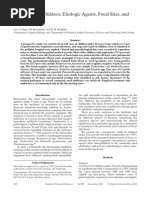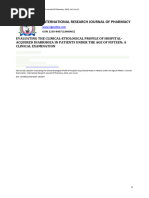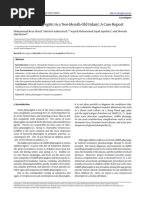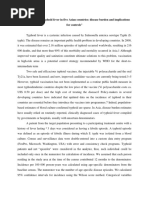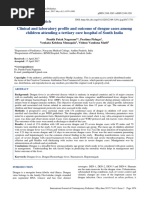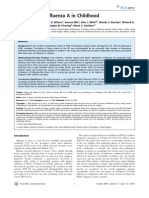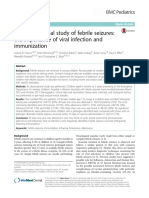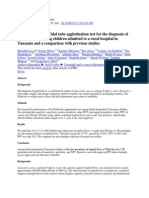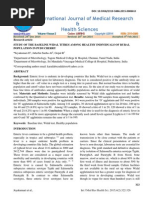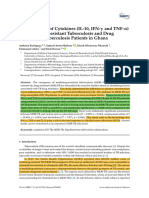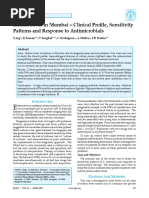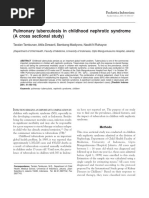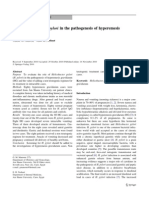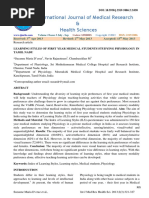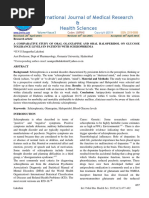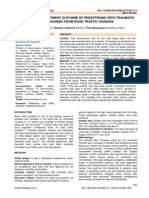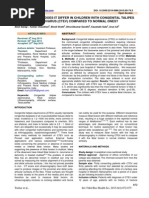5 Sudharshan
5 Sudharshan
Uploaded by
editorijmrhsCopyright:
Available Formats
5 Sudharshan
5 Sudharshan
Uploaded by
editorijmrhsCopyright
Available Formats
Share this document
Did you find this document useful?
Is this content inappropriate?
Copyright:
Available Formats
5 Sudharshan
5 Sudharshan
Uploaded by
editorijmrhsCopyright:
Available Formats
DOI: 10.5958/j.2319-5886.3.2.
054
International Journal of Medical Research & Health Sciences
www.ijmrhs.com Volume 3 Issue 2 (April - Jun) Coden: IJMRHS th Received: 5 Dec 2013 Revised: 5th Jan 2014
Research article
Copyright @2014 ISSN: 2319-5886 Accepted: 11th Jan 2014
CLINICAL PROFILE AND ANTIBIOTIC SENSITIVITY PATTERN OF TYPHOID FEVER IN PATIENTS ADMITTED TO PEDIATRIC WARD IN A RURAL TEACHING HOSPITAL Sudharshan Raj C* Dept. of Pediatrics MNR Medical College, MNR Nagar, Narsapur road, Sanga Reddy, Andhra Pradesh, *Corresponding author email: neelimasudharshan@gmail.com ABSTRACT Introduction: Typhoid is a major endemic health problem among children in India. The last two decades have witnessed the emergence and spread of multidrug resistance against conventional anti typhoid drugs (Ampicillin, chloramphenicol and trimethoprim sulfamethoxazole) especially in the South and South-East Asia. Materials and Methods: Children under twelve years of age with signs and symptoms suggestive of enteric fever were included in this study. Blood cultures were carried by collecting aseptically 5ml of blood and inoculating into bile broth and subcultured onto blood agar and Mac Conkey agar. Antimicrobial sensitivity performed according to CLSI guidelines. Widal test was performed. Other investigations like haemoglobin, total count and differential count of WBC, ESR were carried out. Results: The incidence of enteric fever in this study was 3%. The maximum children were in age group more than 5 years. Maximum cases were admitted during June-September. The most common symptoms were fever, anorexia, vomiting, and pain abdomen. The culture positivity of Salmonella typhi (S.typhi) was 35.4%. The overall positivity of Widal test was 89.8%. Multidrug resistant isolates in this study was 53.6%. Conclusion: Majority of the children were greater than 8 years old. Fever (intermittent type), anorexia, vomiting were the three major symptoms. Among the signs spleenomegaly, hepatomegaly, coated tongue and toxemia were common. Relative bradycardia was not seen. Widal test was found positive in the majority of cases. Blood cultures were positive mainly in the first week of illness. The sensitivity pattern of S.typhi revealed significant proportion of multidrug resistant strains and simultaneous presence of chloramphenicol sensitive and resistant strains in the study. Keywords: Typhoid, Salmonella typhi, multidrug resistant. INTRODUCTION Typhoid fever, also known as enteric fever is caused by the Gram negative bacterium Salmonella enterica serovar Typhi. The disease is mainly associated with low socioeconomic status and poor hygiene, with human beings the only natural host and reservoir of infection. 1 Estimates for the year 2000 suggest that there are approximately 21.5 million infections and 2, 00,000 deaths from typhoid fever globally each year.2-4 Typhoid is a major endemic health problem among children in India. The last two decades have witnessed the emergence and spread of multidrug resistance against conventional antityphoid drugs (Ampicillin, Chloramphenicol and Trimethoprim Sulfamethoxazole) among typhoid Salmonellae, especially in South and Southeast Asia.5,6 Typhoid fever caused by such multidrug-resistant (MDR) strains of Salmonella enterica serotype Typhi presents a serious problem in many developing Int J Med Res Health Sci. 2014;3(2):245-249 245
Sudharshan
countries.7,6 It has left fluoroquinolones as the antimicrobial agents of choice for the treatment of typhoid fever.8 Fluoroquinolones, especially ciprofloxacin, have been in use for more than 18 years and have remained an important weapon against typhoid infections. Effective antimicrobial therapy is required to control morbidity and prevent death from typhoid. This study aims to know the clinical profile of pediatric enteric fever and the sensitivity of the disease to drugs in this region. MATERIALS AND METHODS The prospective study was carried out in a rural teaching hospital over a period of one year. Data regarding admitted children below 12yrs of age with signs and symptoms suggestive of enteric fever and fulfilling any of the following criteria were included in the study. Inclusion criteria: 1. Positive culture for Salmonella typhi 2. Widal titre;TO and TH>=1:160 3. Fourfold or greater rise in Widal titres. Thorough and detailed history, clinical examination and laboratory investigations were done in all cases. The following investigations were done: Routine investigations: Haemoglobin estimation, Total and differential count for white blood cells, Erythrocyte sedimentation ratio, Urine and stool examination, Other investigations such as a chest X ray, liver function test, abdominal sonography were done where ever required Bacterial cultures: Blood cultures were carried out by collecting aseptically 5ml of blood and added to 50ml of bile broth, incubated at 37C for 24hrs. Initial subculture was made after 24hrs and if found negative, further sucultures were made after 48hrs, 4days and 7 days. Positive growths were subjected to standard biochemical tests.9 Species confirmation was done by agglutination with high titre sera. Stool specimens were plated directly onto MacConkey and Salmonella, Shigella agar (SS), and inoculated into Selenite F broth for enrichment. The identity of isolates was confirmed by standard biochemical tests9 and slide agglutination with specific antisera. Widal test: The Widal tube agglutination test was performed according to the manufacturers instruction, using Tidal (Span diagnostics) containing Sudharshan
O and H antigens of S. typhi and S. paratyphi A and S.paratyphi B. Positive and negative serum controls were included, a titre of 1/160 to either antigen in a single serum specimen (in addition to the seroconversion) was taken to be indicative of typhoid fever. The results were correlated with blood culture results and interpreted in conjunction with the patients history and recent clinical presentation on admission. Antimicrobial susceptibility testing: Susceptibility to antimicrobial agents was performed using the Kirby Bauers disc diffusion method as described by the Clinical and Laboratory Standards Institute.10 Antimicrobial agents (discs) tested and reported were obtained from Hi media and included: ampicillin trimethoprim (10g), sulfamethoxazole (25/23.75g), chloramphenicol (30g), ceftriaxone (30g) , ciprofloxacin (5g) , cefixime(30g) and cephalexin(30g). MDR isolates of S. typhi were those resistant to all three first line antityphoid drugs (ampicillin, chloramphenicol and trimethoprim sulfamethoxazole). RESULTS In this study a total number of 79 cases of enteric fever in children 12 years or less, admitted to the pediatric ward were studied. Total number of admissions in the pediatric ward during this period was 2601 so the incidence was 3%. The maximum children were in the age group of more than 5 years (50, 63.3%). The youngest child in this study was 13 months old. Among the children affected 42 were males and 37 females. The male to female ratio was 1.1:1. Cases were admitted throughout the year showing the endemicity of the disease. Maximum cases were admitted during June-September 36 (45.6%) (Table1). The most common presenting symptom was fever 79 (100%) followed by anorexia 43 (54.4%) and vomiting 38 (48.1%), pain abdomen 21 (26.6%), loose motions 10 (12.6%), altered sensorium 10 (12.6%). In this study maximum cases 35 (49.3%) had fever for 8-14 days prior to admission. Almost half the cases 39 (49.4%) showed intermittent type of fever. The signs of enteric fever in this study were (table2).
Int J Med Res Health Sci. 2014;3(2):245-249
246
Complications seen in this study were bronchitis 9 (11.3%), encephalopathy 7 (8.9%), cholecystitis 5 (6.3%), enteric hepatitis 3 (3.8%), shock 2 (2.53%) and paralytic ileus 1 (1.26%). Routine investigations: In this study haemoglobin < 10gm/dl was found in 41.8% of cases. Majority of the children had WBC count in the range 5000-10000/cu mm (70.9%). Table 1: Month wise distribution of cases Month No. of cases Percentage January 05 6.3% February 04 5.1% March 04 5.1% April 05 6.3% May 07 8.8% June 08 10.2% July 08 10.2% August 12 15.2% September 08 10.2% October 05 6.3% November 06 7.6% December 07 8.8% Total 79 100% Table 2: Signs of enteric fever Signs Number cases Tachycardia 64 Spleenomegaly 54 Hepatomegaly 44 Coated tongue 41 Pallor 41 of Percentage 81% 68.4% 55.7% 51.9% 51.9%
increased in 2nd and subsequent weeks (91.4% & 100% ) respectively. Among 15 cases which were widal negative in first week 9 cases (60%) showed rise in titres. The overall positivity of Widal test was 89.8%. The sensitivity of the Widal test was 71.4%. Antibiotic resistance pattern in this study was (table 3) DISCUSSION The incidence of enteric fever in this study was 3%, which was in accordance with the studies conducted by Pohawalla et al who also reported an incidence of 3% 11 but Bavdekar etal reported 23%12 and Taneja 19%.13 The maximum children were in the age group of more than 5years (63%) which is comparable to that in Pandey K.K et al 86.5% 14 and Subindra 73%.15 The male to female ratio in this study was 1.1:1. Pandey etal reported 1.2:1.14 In this study cases were admitted throughout the year showing the endemicity of the disease. Maximum cases were admitted during June-September (45.6%). This period coincides with the onset of monsoon and increase in housefly population, which facilitates faeco-oral transmission. Pandey K.K et al reported maximum incidence between May-July14 and Arora et al reported 40.6% cases in the period of September-October.16 The most common symptoms were fever (100%), anorexia (54.4%), vomiting (48.1%), pain abdomen (26.6%), constipation (25.3%), loose motions (12.6%) and altered sensorium (12.6%). These symptoms were also seen in studies conducted by Taneja Sood et al 13 and Pandey KK et al. 14 In the present study maximum cases (44.3%) had fever for 8-14 days prior to admission which was comparable to that of Kapoor JP et al (51.6%).16 Almost half the cases (49.4%) showed intermittent type of fever. No case in this study had stepped ladder type of fever and this finding is same as reported by Pandey KK etal14, Kapoor JP, et al. 17 The use of antipyretics and antibiotics were probably responsible for this pattern. The common signs seen were spleenomegaly (68.4%), hepatomegaly (55.7%), coated tongue (51.9%), pallor (51.9%) which was also reported by Kapoor JP et al 17. The other signs tachycardias, toxic look, dehydration seen in this study were not reported by others. 247
Table 3: Antibiotic resistance pattern of salmonella typhi Antibiotic Number n = Percentage 28 Multi drug resistant 15 53.6% Chloramphenicol 18 64.2% Ampicillin 25 89.3% Co-trimoxazole 27 96.4% Ciprofloxacin 28 00% Ceftriaxone 28 00% Cefixime 28 00% Cephalexin 13 46.4% In this study S.typhi was isolated in 28 out of 79 cases (35.4%), 17 (53.1%) cases were Widal positive in 1st week showed TO & TH >1:160.The positivity Sudharshan
Int J Med Res Health Sci. 2014;3(2):245-249
In this study haemoglobin<10gm/dl was found in 41.8% of cases. This finding was seen in 64.5% by Kapoor et al 16 and 62% by Arora etal.16 Majority of the children (70.9%) had a WBC count in the range of 5000-10000/cumm which was comparable to 67.9% and 85.6% as reported by Pandey et al 14 and Mishra et al .18 The overall positivity of widal test in this study was 89.8% as comparable to 90% reported by Manchanda et al.18 The culture positivity in this study was 35.4% which is in concordance with that of Manchanda et al. 19 Among the 28 culture positive cases; Widal test was positive in 20 cases (71.4%). In eight cases Widal test remained negative on repeating after one week. The sensitivity of the Widal test in the present study was 71.4%.Use of antibiotics prior to admission was probably responsible for low culture positivity rates. The present study found 53.6% isolates to be multi drug resistant. Garg et al20 and Arora et al 16 reported 67% and 82.5% respectively. 64.2%. 89.3%, 96.4% of the isolates were resistant to chloramphenicol, ampicillin and co-trimoxazole. No resistance was found to ciprofloxacin, Cefixime and ceftriaxone. Lower percentage of chloramphenicol (64.2%) resistance may be due to re-emerging sensitivity as reported by Urmila jhamb. 21 Widespread use of cotrimoxazole, ampicillin, cephalexin might be responsible for resistance to these drugs. In this study 37 cases (46.8%) were put on ceftriaxone and 42 cases (53.2%) were given ciprofloxacin. Among the ceftriaxone treated cases the range for time to defervescence (TTD) was 2-6 days, the mean being 3.641.06 days.Urmila Jhamb reported a TTD with ceftriaxone of 4 days.21 Among the ciprofloxacin treated cases; the TTD ranged from 2-12 days. The mean being 3.560.99 days. CONCLUSION The disease is endemic and account for a significant proportion of hospital admissions. Boys and girls of all ages > 1 year were seen to be affected, majority being >8 years old. Fever (intermittent type), anorexia, vomiting were the three major symptoms. Among the signs spleenomegaly, hepatomegaly, coated tongue and toxemia were common. Relative bradycardia was not seen. Bronchitis, encephalopathy, hepatitis, and cholecystitis were common complications. Widal test was found Sudharshan
positive in majority of cases. Blood cultures were positive mainly in the first week of illness. The sensitivity pattern of S.typhi revealed significant proportion of multidrug resistant strains and simultaneous presence of chloramphenicol sensitive and resistant strains in the study. Both ciprofloxacin and ceftriaxone were effective in the treatment with no major adverse effects. REFERENCES 1. Evanson Mweu and Mike English. Typhoid fever in children in Africa. Trop Med Int Health. 2008;13(4): 53240 2. Crump J, Luby S, Mintz E. The global burden of typhoid fever. Bulletin of the World Health Organization. 2004;82:34653 3. Bhan M, Bahl R, Bhatnagar S. Typhoid and paratyphoid fever. Lancet. 2005;366:74962 4. Bhutta Z. Current concepts in the diagnosis and treatment of typhoid fever. British Medical Journal. 2006;333:7882. 5. Chandel DS, Chaudhry R, Dhawan B, Paudey A, Dey AB. Drug-resistant Salmonella enterica serotype Paratyphi A in India. Emerg Infect Dis 2000; 6: 42021. 6. Rowe B, Ward LR, Threlfall EJ. Multidrugresistant Salmonella Typhi: a worldwide epidemic. Clin Infect Dis 1997;24(1): S10609. 7. Ivanoff B, Levine MM. Typhoid fever: continuing challenges from a resilient bacterial foe. Bull Inst Pasteur. 1997;95: 12942 8. Parry CM, Hien TT, Dougan G, White NJ, Farrar JJ. Typhoid fever. N Engl J Med.2002; 34:1770 82. 9. Colle JG, Miles RS, Watt B. Tests for Identification of bacteria. Mackie and Mc Cartney Practical Medical Microbiology, Churchill Livingstone 2008: 14th edition : 131149. 10. Clinical and Laboratory Standards Institute. Methods for Disk Susceptibility Tests for Bacteria that Grow Aerobically. Wayne, PA: Clinical and Laboratory Standards Institute. 2005;7th edn, document M2A8 11. Pohawalla JN, Bhandari NR. Some observations on typhoid encephalopathy in chidren. I. J. of child health 1960;9:375-80.
Int J Med Res Health Sci. 2014;3(2):245-249
248
12. Bavdekar A, Chaudhari M, Bhave S, Pandit A.Ciprofloxacin in typhoid fever. Indian j pediatr 1991;58(3):335-39 13. Taneja PN, Sood SC. Typhoid fever :Clinical picture and diagnosis .I.J. of child health 1961;69-76. 14. Pandey KK, Srinivasan S, Mahadevan S, Nalini P, Rao RS. Typhoid fever below five years. Indian pediatr 1990;27(2):153-6. 15. Sudhindra BK. Enteric fever in young children. Indian pediatr 1995;32:1127 16. Arora RK, Gupta A, Joshi NM, Kataria VK, Lall P, Anand AC. Multidrug resistant typhoid fever: Study of outbreak in Calcutta. Indian pediatr 1992;29(1):61-65 17. Kapoor JP, Man Mohan, Vibha Talwar, Daral TS, Bhargava SK. Typhoid fever in young children. Indian pediatr 1985;22(11):811-13 18. Mishra AK, Patwari VK, Anand PK, Pillai S, Aneja J, Chandra, Sharma D. A clinical profile of multidrug resistant typhoid fever. Indian pediatr 1991;28(10):1171-74 19. Manchanda SS, Harjit Singh, Chitkara HL. A Review of 270 cases of enteric fever in children. Ind J Child Health 1959; 8 : 273-80 20. Garg K, Mangal N, Mathur HC. Clinical profile of multi drug resistant typhoid fever in Jaipur city. Indian pediatr 1994;31(2):191-93 21. Urmila Jhamb. Multidrug resistant typhoid in children. NCPID IAP 2001
Sudharshan
Int J Med Res Health Sci. 2014;3(2):245-249
249
You might also like
- Typhoid JournalDocument7 pagesTyphoid JournalRegina AyediaNo ratings yet
- Original Article: Clinical and Laboratory Features of Typhoid Fever in ChildhoodDocument6 pagesOriginal Article: Clinical and Laboratory Features of Typhoid Fever in ChildhoodRidha Surya NugrahaNo ratings yet
- Bacteremia in Children-JTPDocument5 pagesBacteremia in Children-JTPRomica MarcanNo ratings yet
- Jurnal ThyphoidDocument10 pagesJurnal ThyphoidAndrea ChristantyNo ratings yet
- Differences in Clinical and Laboratory Findings Between Group D and Non-Group D Non-TyphoidalDocument10 pagesDifferences in Clinical and Laboratory Findings Between Group D and Non-Group D Non-TyphoidalBana NanaNo ratings yet
- Sitasi 10Document6 pagesSitasi 10Putri Cyntia DewiNo ratings yet
- Clinical Profile and Outcome of Dengue Fever CasesDocument2 pagesClinical Profile and Outcome of Dengue Fever CasesValencius SunandarNo ratings yet
- 11 3854Document4 pages11 3854Yao RaNo ratings yet
- Irjp Paediatric Feb 23 Arif Diarrhoea+in+ChildrenDocument5 pagesIrjp Paediatric Feb 23 Arif Diarrhoea+in+Childrenk.smilyopenventioNo ratings yet
- Pharyngitis Case ReportDocument4 pagesPharyngitis Case ReportMelissa TiofanNo ratings yet
- A Study of Typhoid Fever in Five Asian Countries: Disease Burden and Implications For ControlsDocument4 pagesA Study of Typhoid Fever in Five Asian Countries: Disease Burden and Implications For ControlsPutu SuartiniNo ratings yet
- Entericfever 201810061138061823280Document4 pagesEntericfever 201810061138061823280Cindy HerwitiNo ratings yet
- Rab 1Document9 pagesRab 1Belia DestamaNo ratings yet
- 838 3348 1 PBDocument7 pages838 3348 1 PBararapiaNo ratings yet
- Pulmonary Tuberculosis As A Differential Diagnosis of PneumoniaDocument18 pagesPulmonary Tuberculosis As A Differential Diagnosis of PneumoniaKadek AyuNo ratings yet
- 282 F 4 e 2 Edaf 124 A 0Document12 pages282 F 4 e 2 Edaf 124 A 0Mazin AlmaziniNo ratings yet
- Typhoid WidalDocument4 pagesTyphoid WidalamaliamldNo ratings yet
- Brucellosis Suspicion Is The Most Important Criterion For Diagnosis Particularly in Endemic RegionsDocument8 pagesBrucellosis Suspicion Is The Most Important Criterion For Diagnosis Particularly in Endemic RegionsjodyhernantoNo ratings yet
- Clinical Profile and Outcome in Children of Dengue Hemorrhagic Fever in North IndiaDocument7 pagesClinical Profile and Outcome in Children of Dengue Hemorrhagic Fever in North IndiaAna Rosida SafwanNo ratings yet
- Parasitic Infections in Malaysia: Changing and ChallengesDocument10 pagesParasitic Infections in Malaysia: Changing and Challengesiloveyou_143No ratings yet
- Intestinal Parasites in Children With Diarrhea in Delhi, IndiaDocument5 pagesIntestinal Parasites in Children With Diarrhea in Delhi, IndiaOva OlegnaNo ratings yet
- Cefpodoxime Vs Cefixime in LRTI, IndianJPediatrDocument5 pagesCefpodoxime Vs Cefixime in LRTI, IndianJPediatrAnonymous so6ZnlKyw100% (1)
- Mcasecsrfcampylob PDFDocument6 pagesMcasecsrfcampylob PDFTeófilo Negróss MassáiNo ratings yet
- IndianJMedPaediatrOncol34285-8146442 223744Document4 pagesIndianJMedPaediatrOncol34285-8146442 223744Nanda Asyura RizkyaniNo ratings yet
- Microbiological Evaluation of Nosocomial Infections by Using National Nosocomial Infection Surveillance (NNIS) SystemDocument13 pagesMicrobiological Evaluation of Nosocomial Infections by Using National Nosocomial Infection Surveillance (NNIS) SystemJanatinAzaNo ratings yet
- Journal InfluenzaDocument6 pagesJournal InfluenzaAzzie NiazieNo ratings yet
- Javadneg A 10 28 4 63c47c3 PDFDocument18 pagesJavadneg A 10 28 4 63c47c3 PDFLhia PrisciliiaNo ratings yet
- An Observational Study of Febrile Seizures: The Importance of Viral Infection and ImmunizationDocument6 pagesAn Observational Study of Febrile Seizures: The Importance of Viral Infection and Immunizationnavali rahmaNo ratings yet
- A Comparative Study of Typhidot and Widal Test For Rapid Diagnosis of Typhoid FeverDocument5 pagesA Comparative Study of Typhidot and Widal Test For Rapid Diagnosis of Typhoid FeverArbusa86No ratings yet
- Preserving Efficacy of Chloramphenicol Against Typhoid Fever in A Tertiary Care Hospital, IndiaDocument5 pagesPreserving Efficacy of Chloramphenicol Against Typhoid Fever in A Tertiary Care Hospital, IndiaMelaniNo ratings yet
- Jurnal 2Document12 pagesJurnal 2zingioNo ratings yet
- 13 Jeyakumari EtalDocument5 pages13 Jeyakumari EtaleditorijmrhsNo ratings yet
- Basingnaa-Cytokine in DR TBDocument10 pagesBasingnaa-Cytokine in DR TBHatif ChanifahNo ratings yet
- Enteric Fever in Mumbai - Clinical Profile, Sensitivity Patterns and Response To AntimicrobialsDocument4 pagesEnteric Fever in Mumbai - Clinical Profile, Sensitivity Patterns and Response To AntimicrobialsHaidar HanifNo ratings yet
- 12538-Article Text-62108-1-10-20221227Document7 pages12538-Article Text-62108-1-10-20221227koaslife2022No ratings yet
- Literature Review On Typhoid FeverDocument4 pagesLiterature Review On Typhoid Feverc5h4drzjNo ratings yet
- Original Article: Pulmonary Tuberculosis in Childhood Nephrotic Syndrome (A Cross Sectional Study)Document5 pagesOriginal Article: Pulmonary Tuberculosis in Childhood Nephrotic Syndrome (A Cross Sectional Study)Maghfirah RahimaNo ratings yet
- Prevelance of Infection in Daibetic Children With H. Pylori Bacteria and Risk Factors of H. Pylori in Diabetic ChildrenDocument3 pagesPrevelance of Infection in Daibetic Children With H. Pylori Bacteria and Risk Factors of H. Pylori in Diabetic ChildrenBaru Chandrasekhar RaoNo ratings yet
- Typhoid Fever in Children in Africa : ViewpointDocument9 pagesTyphoid Fever in Children in Africa : ViewpointFaiz Yunanto MangoendiprodjoNo ratings yet
- Original ArticleDocument6 pagesOriginal Articlethasim.evrNo ratings yet
- Typhoid FeverwwwwwwDocument7 pagesTyphoid FeverwwwwwwadiNo ratings yet
- dengue-infection (1)Document5 pagesdengue-infection (1)bryan leon trujilloNo ratings yet
- Enteric Fever 2013Document3 pagesEnteric Fever 2013aminceloNo ratings yet
- Typhoid BangladeshDocument11 pagesTyphoid BangladeshMarindaRamadhanyNo ratings yet
- Antibiotics Tonsillitis: in The ofDocument9 pagesAntibiotics Tonsillitis: in The ofwicak_spNo ratings yet
- Typhoid Fever: A ReviewDocument7 pagesTyphoid Fever: A ReviewJesicca SNo ratings yet
- 67 1437543936 PDFDocument5 pages67 1437543936 PDFrivandiNo ratings yet
- Role of Helicobacter Pylori in The Pa Tho Genesis of SisDocument5 pagesRole of Helicobacter Pylori in The Pa Tho Genesis of SisMaricris Palacios VergaraNo ratings yet
- Diagnosis and Treatment of Human Salmonellosis inDocument8 pagesDiagnosis and Treatment of Human Salmonellosis inRajihaNo ratings yet
- UmanDocument5 pagesUmanevenunholicNo ratings yet
- Comparative Study of Typhidot-M With Widal and Blood Culture in Diagnosis of Enteric FeverDocument4 pagesComparative Study of Typhidot-M With Widal and Blood Culture in Diagnosis of Enteric FeverPranay BhosaleNo ratings yet
- Jurnal Reading 3Document9 pagesJurnal Reading 3Harmas Novryan FarezaNo ratings yet
- Article On DengueDocument6 pagesArticle On Dengueاحمد احمدNo ratings yet
- Epidemiology DLL Peritonsil Abses PDFDocument7 pagesEpidemiology DLL Peritonsil Abses PDFdamaiswariNo ratings yet
- Comparison Study Between Typhoid Fever and Tuberculosis Patients To Induce and Produce of Th1 Cytokines Il18 and IfnDocument7 pagesComparison Study Between Typhoid Fever and Tuberculosis Patients To Induce and Produce of Th1 Cytokines Il18 and IfnNadia CahyaNo ratings yet
- Vol. 6Spl. Edn. P. 99 104Document6 pagesVol. 6Spl. Edn. P. 99 104IRSNo ratings yet
- 4 PMID 37840726 SalmonellaDocument9 pages4 PMID 37840726 Salmonellaajaya basnetNo ratings yet
- medip,+IJCP-2356+O (3)Document6 pagesmedip,+IJCP-2356+O (3)Smile GandhiNo ratings yet
- Title Retrospective Review of Typhoid and Paratyphoid Fever in A Regional HospitalDocument32 pagesTitle Retrospective Review of Typhoid and Paratyphoid Fever in A Regional HospitalHam FGNo ratings yet
- Complementary and Alternative Medical Lab Testing Part 5: GastrointestinalFrom EverandComplementary and Alternative Medical Lab Testing Part 5: GastrointestinalNo ratings yet
- Ijmrhs Vol 2 Issue 3Document399 pagesIjmrhs Vol 2 Issue 3editorijmrhs100% (1)
- Ijmrhs Vol 4 Issue 4Document193 pagesIjmrhs Vol 4 Issue 4editorijmrhs0% (1)
- Ijmrhs Vol 2 Issue 4Document321 pagesIjmrhs Vol 2 Issue 4editorijmrhsNo ratings yet
- Ijmrhs Vol 4 Issue 2Document219 pagesIjmrhs Vol 4 Issue 2editorijmrhsNo ratings yet
- Ijmrhs Vol 3 Issue 3Document271 pagesIjmrhs Vol 3 Issue 3editorijmrhsNo ratings yet
- Ijmrhs Vol 4 Issue 3Document263 pagesIjmrhs Vol 4 Issue 3editorijmrhsNo ratings yet
- 47serban Turliuc EtalDocument4 pages47serban Turliuc EtaleditorijmrhsNo ratings yet
- Ijmrhs Vol 3 Issue 2Document281 pagesIjmrhs Vol 3 Issue 2editorijmrhsNo ratings yet
- Ijmrhs Vol 2 Issue 1Document110 pagesIjmrhs Vol 2 Issue 1editorijmrhs100% (1)
- Williams-Campbell Syndrome-A Rare Entity of Congenital Bronchiectasis: A Case Report in AdultDocument3 pagesWilliams-Campbell Syndrome-A Rare Entity of Congenital Bronchiectasis: A Case Report in AdulteditorijmrhsNo ratings yet
- Ijmrhs Vol 2 Issue 2Document197 pagesIjmrhs Vol 2 Issue 2editorijmrhsNo ratings yet
- Ijmrhs Vol 3 Issue 4Document294 pagesIjmrhs Vol 3 Issue 4editorijmrhsNo ratings yet
- Ijmrhs Vol 3 Issue 1Document228 pagesIjmrhs Vol 3 Issue 1editorijmrhsNo ratings yet
- 41anurag EtalDocument2 pages41anurag EtaleditorijmrhsNo ratings yet
- 48 MakrandDocument2 pages48 MakrandeditorijmrhsNo ratings yet
- 40vedant EtalDocument4 pages40vedant EtaleditorijmrhsNo ratings yet
- Ijmrhs Vol 1 Issue 1Document257 pagesIjmrhs Vol 1 Issue 1editorijmrhsNo ratings yet
- Pernicious Anemia in Young: A Case Report With Review of LiteratureDocument5 pagesPernicious Anemia in Young: A Case Report With Review of LiteratureeditorijmrhsNo ratings yet
- 45mohit EtalDocument4 pages45mohit EtaleditorijmrhsNo ratings yet
- 38vaishnavi EtalDocument3 pages38vaishnavi EtaleditorijmrhsNo ratings yet
- Recurrent Cornual Ectopic Pregnancy - A Case Report: Article InfoDocument2 pagesRecurrent Cornual Ectopic Pregnancy - A Case Report: Article InfoeditorijmrhsNo ratings yet
- 35krishnasamy EtalDocument1 page35krishnasamy EtaleditorijmrhsNo ratings yet
- 37poflee EtalDocument3 pages37poflee EtaleditorijmrhsNo ratings yet
- 36rashmipal EtalDocument6 pages36rashmipal EtaleditorijmrhsNo ratings yet
- 34tupe EtalDocument5 pages34tupe EtaleditorijmrhsNo ratings yet
- 33 Prabu RamDocument5 pages33 Prabu RameditorijmrhsNo ratings yet
- 28nnadi EtalDocument4 pages28nnadi EtaleditorijmrhsNo ratings yet
- 31tushar EtalDocument4 pages31tushar EtaleditorijmrhsNo ratings yet


